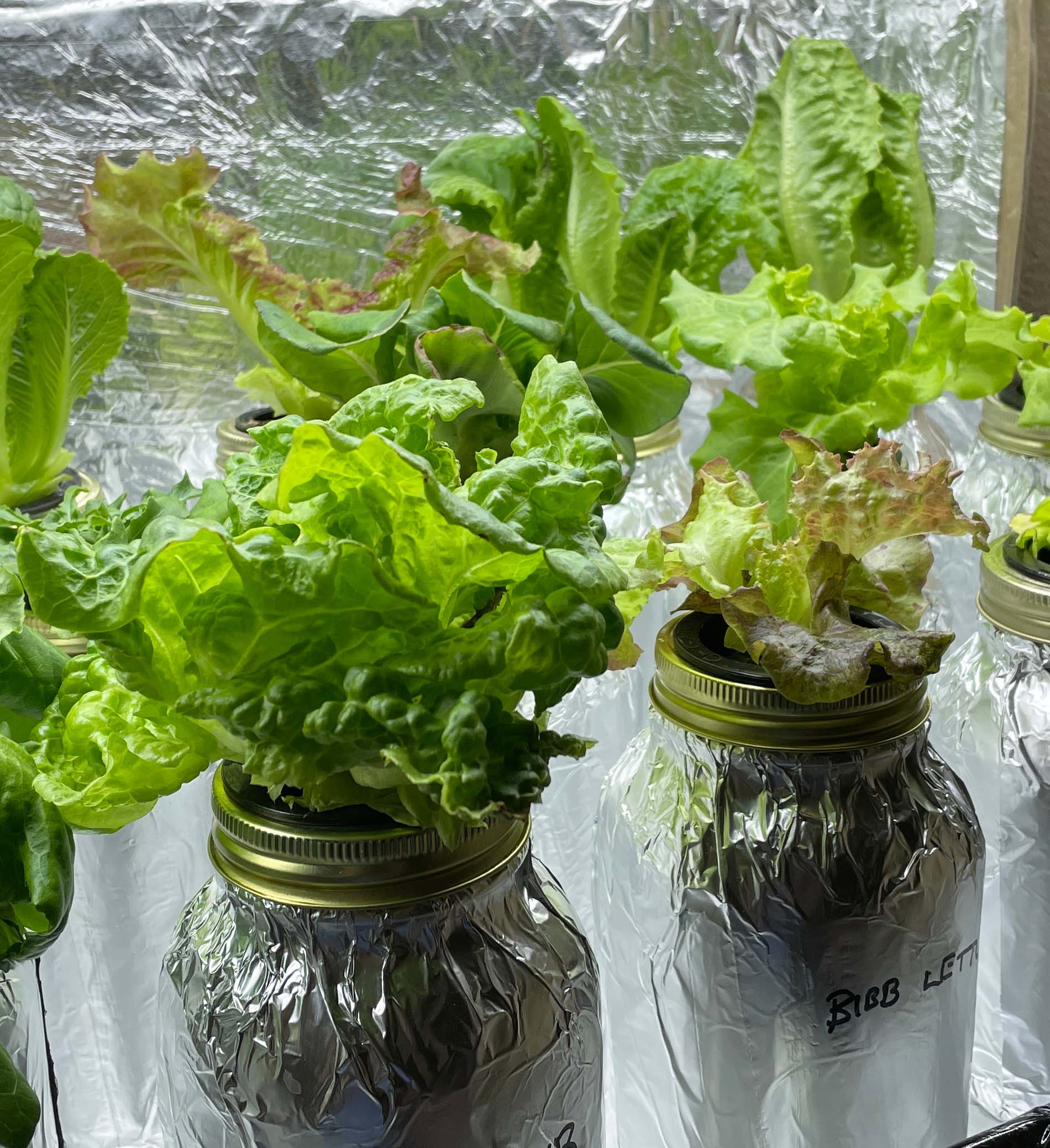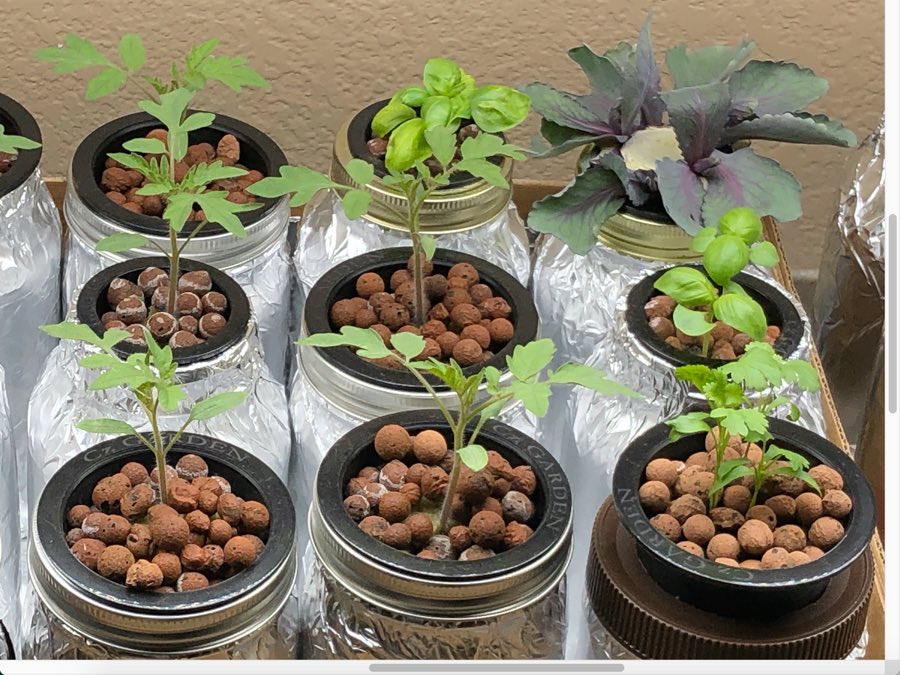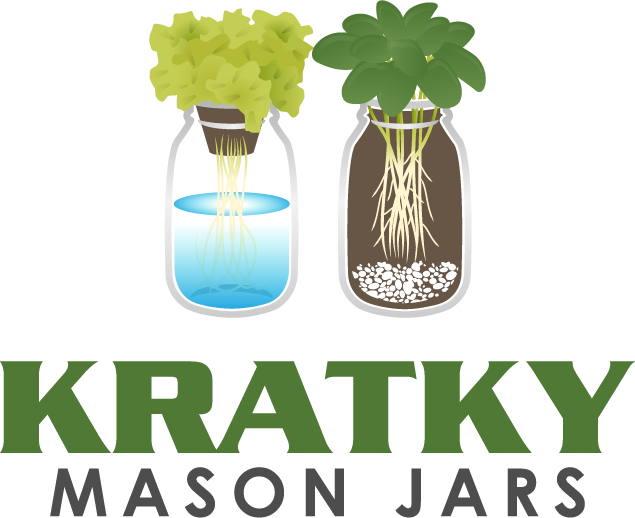Kratky Mason Jars and Mason Jar Hydroponics
Learn how to grow hydroponic mason jar plants using Kratky mason jars. Using the Kratky Method of Hydroponics, learn how simple it can be to grow herbs, lettuce and vegetables in easy to manage mason jars, right in your own home. This inexpensive, easy method of growing hydroponically can be achieved by anyone, anywhere, regardless of your age or where you live. We will show you how!
Kratky Hydroponic Seeds – Our Favorite Seeds to Grow in Mason Jars Using Kratky Hydroponics
Advertisement
As an Amazon Associate I earn from qualifying purchases.
What is the Kratky Method of Hydroponics?
Before we jump in and start growing our indoor garden using mason jar hydroponics, take a few minutes to learn about the Kratky Method of Hydroponics.
The Kratky method of hydroponics is a simple and efficient way to grow plants without the use of soil. This method uses a small amount of water and nutrients to support plant growth, making it an ideal choice for those who want to reduce their environmental impact or save on resources. The Kratky method is also well-suited for growing plants in areas with limited space or resources. That’s where mason jars come in.
Ready to learn all about growing in a Kratky Mason Jar?
Growing delicious fruits and vegetables using Kratky Hydroponics in mason jars is one of the most fun and rewarding gardening methods.
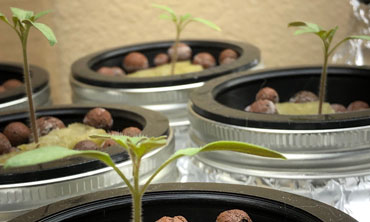
Most plants grow well in a small space, such as this mason jar.
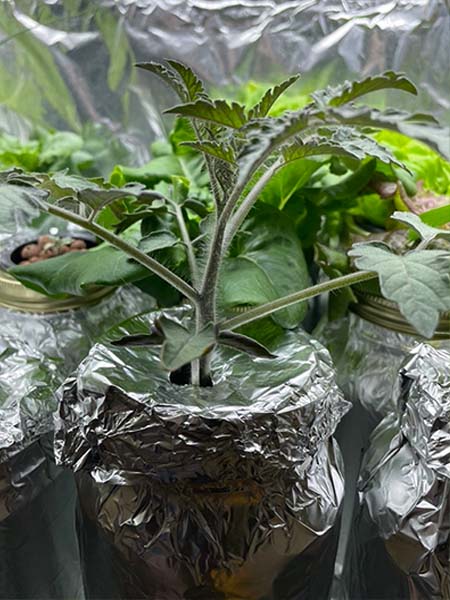
Growing Tomatoes, Basil, Lettuce and More Using the Kratky Method of Hydroponics with Mason Jars
If you’re interested in growing peppers hydroponically, you may want to consider using the Kratky method using mason jars. This is a simple, passive form of hydroponics that doesn’t require any pumps or moving parts, and can be easily set up with inexpensive materials.
To get started, you’ll need a container to hold your plants. I like to use clear mason jars because they’re cheap and easy to find, but you can use any type of container that’s big enough to fit your plants. You’ll also need some net pots (these can be found at most garden stores) and some hydroton clay pellets.
Once you have your supplies gathered, fill your container with water and add enough hydroton.
Kratky Hydroponic Basil – Our Favorites for Growing Basil with the Kratky Method in Mason Jars
Advertisement
As an Amazon Associate I earn from qualifying purchases.
In the world of hydroponics, mason jars have become iconic vessels for the innovative Kratky method, a simple yet effective technique for cultivating plants without soil. With the Kratky method, nutrient solution levels are carefully maintained within the mason jars, providing essential nutrients for plant growth. This self-contained system eliminates the need for complex irrigation setups, making it accessible to beginners and experienced gardeners alike.
What to Put in Your Mason Jars
Mason jar hydroponics is simple. To start, growers fill the mason jars with a precise mixture of water and plant nutrients, creating a nutrient-rich reservoir for the roots of their chosen plants. Seedlings or germinated seeds are carefully placed into the growing medium within the jars, where they begin their journey towards robust root development. The water level is monitored closely, ensuring that the roots receive adequate hydration while allowing for sufficient oxygenation to support healthy growth. Light exposure plays a crucial role in the process, as plants thrive under the gentle glow of natural or artificial light sources.
As the plants progress, growers attentively observe nutrient absorption, pH levels, and overall plant health. Maintenance tasks such as adjusting nutrient levels, monitoring water quality, and providing necessary support for growing plants are integral to the success of the Kratky mason jar system. With patience and dedication, growers are rewarded with bountiful harvests of fresh herbs, leafy greens, and even compact fruits like strawberries and cherry tomatoes. This sustainable gardening method demonstrates the potential for innovation within the realm of urban agriculture, offering a glimpse into a future where anyone can cultivate their own nutritious produce, regardless of space constraints or traditional gardening limitations.
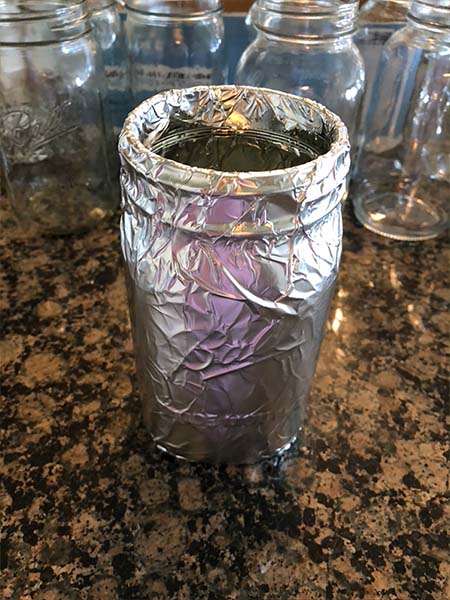
We started using foil to wrap our mason jars. After one or two plants were grown, we found the water would get under the foil and cuase issues. We eventually switched to the cool mason jar covers below.
Kratky Mason Jar Hydroponics – Our Favorites for Growing with the Kratky Method with Mason Jars
Advertisement
I bought these CZ net cups and will never buy another brand. They have been used year over year 5+ years.
I love these gro-block rockwool cubes. They keep the rockwool off your hands and soak well.
Before I got these, I used clay pebbles and/or foam cutouts. These fit so much better and block all light.
This is only wishlist. I plan on trying these in the the fall. You can see in my pics I currently use tin foil.
As an Amazon Associate I earn from qualifying purchases.
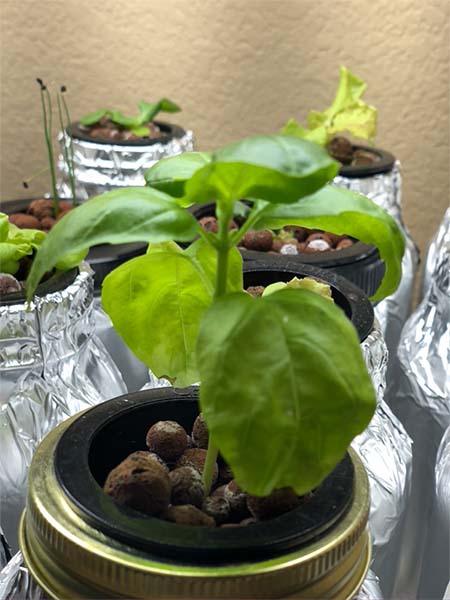
Can you grow herbs in mason jars with hydroponics? Yes, see my Kratky Basil growing in mason jars. The herbs grow easily, allowing you to grow basil year round in a small space indoors. Mason jar hydroponics is one of the funnest garden methods.
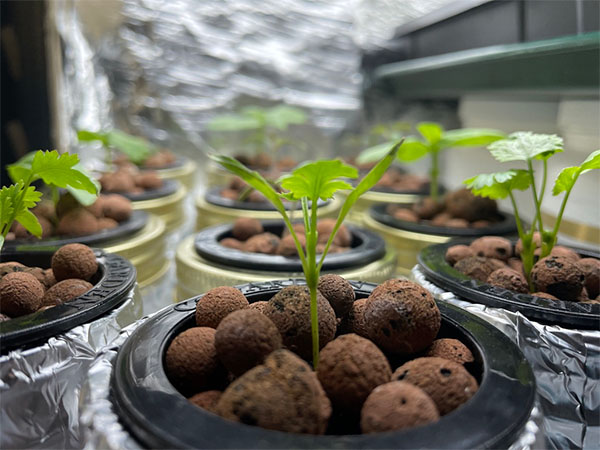
Mason jar hydroponics cilantro grown in mason jars, clay pebbles and rock wool. Hydroponic mason jar herbs are one of my favorite things to grow. Imagine fresh herbs all year long with this simple mason jar method or what I call Kratky mason jar hydroponics.
Can You Grow Herbs in Glass Jars?
Yes, you can grow herbs in glass jars. Glass jars can be suitable containers for growing herbs indoors, especially using soilless methods like Kratky. Make sure to choose herbs that don’t require extensive root space and can thrive in relatively small containers. Additionally, select a sunny spot for your glass jar herb garden to ensure the plants receive sufficient light or grow under LED lighting.
Grow Herbs in Glass Mason Jars
To grow herbs in glass mason jars, follow these steps:
Choose suitable herbs: Select herbs that can thrive in indoor environments and don’t require extensive root space. Examples include basil, mint, parsley, chives, oregano, and thyme.
Select appropriate jars: Use clean glass jars with wide openings to allow for adequate air circulation. Mason jars or recycled glass containers work well.
Prepare the hydroponic solution: Prepare the hydroponic solution that is best for the herb you are growing. Fill the jar with the mix until it reaches the bottom of your net pot, just above the bottom of the roots. Leave room for air to get to your roots.
Plant the herbs: Plant herb seeds or seedlings in rockwool or other growing medium in the net pot. Ensure the medium gets plenty of water (clay pebbles will soak up water and deliver to the roots).
Provide adequate light: Place the glass jars in a sunny location where the herbs can receive at least 6-8 hours of sunlight per day. If natural light is limited, consider supplementing with grow lights.
Water appropriately: Check the water level regularly and add water as needed. Check that your solution does not deplete and the roots are touching.
Maintain the herbs: Trim the herbs regularly to encourage bushy growth and prevent them from becoming leggy. Harvest leaves as needed for culinary use, but avoid removing more than one-third of the plant at a time.
Fertilize occasionally: Herbs grown in glass jars may benefit from occasional fertilization with a balanced solution diluted to half strength.
By following these steps, you can grow herbs in glass jars indoors, providing fresh ingredients for cooking while adding greenery to your living space.
Growing in Mason Jars Hydroponically with the Kratky Method
Advertisement
Amber glass mason jars with wide lids can block more light but would still need covered in order to block light.
These mason jars will block our light and make it easy to write on without painting yourself.
12-pack of 32 oz mason jars with wide mouths, which are recommended for Kratky mason jar growing.
12-pack of 16 ounce mason jars for Kratky Hydroponic growing. These are a staple for growing with mason jars.
As an Amazon Associate I earn from qualifying purchases.
Kratky Plants to Grow in Mason Jars
While you can grow most anything hydroponically, growing in mason jars is limited to the container size. You can find mason jars in various sizes, from a pint to 2 gallons. We find that dwarf varieties do very well in mason jars.
Mason Jar Herbs:
-
- Basil
- Parsley
- Cilantro
- Mint
- Chives
- Thyme
- Oregano
Mason Jar Microgreens:
-
- Radish
- Broccoli
- Mustard
- Sunflower
- Pea shoots
Mason Jar Leafy Greens:
-
- Lettuce (butterhead, romaine, and leaf lettuce)
- Spinach
- Kale
- Arugula
- Swiss chard
- Bok choy
Mason Jar Dwarf Varieties:
-
- Tomatoes
- Eggplant
- Zucchini
- Summer squash
- Cucumber
Mason Jar Compact Varieties:
-
- Strawberries
- Cherry Tomatoes
- Peppers
- Green Onions/Scallions
- Cucumbers
- Beans (bush varieties)
- Peas (bush varieties)
- Celery (regrown from scraps)
- Carrots (smaller varieties suitable for containers)
- Beets (smaller varieties suitable for containers)
- Radishes
- Kaleidoscope Mix (a blend of colorful lettuce varieties)
- Baby Greens Mix
- Arugula






